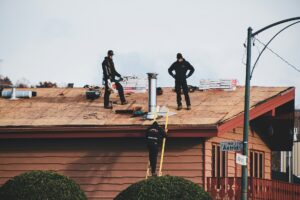Roof insulation can have a transformative impact on your home’s energy efficiency and comfort. By reducing heat transfer through your roof, you lessen strain on heating and cooling systems, maintain a more consistent indoor temperature, and help extend your roof’s lifespan. Yet, with multiple insulation types—ranging from fiberglass batts to spray foam—you might wonder which one is best for your situation. The answer depends on your climate, roof design, budget, and willingness to tackle (or hire out) regular upkeep.
Below, we’ll outline the most common roof-insulation materials, discuss how they perform, and offer tips to guide your decision-making. Whether you’re building a new home or looking to upgrade an existing roof, this overview will help you understand the pros and cons of each approach.
Why Roof Insulation Matters
At its core, insulation slows the transfer of heat—making it harder for warmed air to escape during winter and for hot air to penetrate in summer. Properly insulated roofs:
- Cut energy bills by keeping cooling and heating demands lower.
- Reduce temperature fluctuations, improving comfort in your top floors or attic spaces.
- Prevent moisture buildup in the attic, helping avoid mold and wood rot.
- Support roof longevity by minimizing stress on shingles caused by extreme temperature differences.
According to the U.S. Department of Energy, most homes can benefit from additional insulation, especially in attics or roof assemblies that are under-insulated. The next step is determining which material offers the right blend of performance, cost, and practicality for your home.
Common Roof Insulation Types
While there are many insulation materials on the market, some are more common—and often more appropriate—when it comes to roofs. Below is a closer look at the main contenders.
Fiberglass Batts or Rolls
Fiberglass insulation is one of the most familiar options. It consists of fine glass fibers woven into rolls or batts (pre-cut sheets):
- Pros:
- Widely available, making it easy to find in stores.
- Affordable compared to many other insulation types.
- Easy to install for DIYers (though you must wear protective gear to minimize skin or lung irritation).
- Cons:
- Must fit snugly around rafters and in hard-to-reach corners to prevent gaps, which can lessen effectiveness.
- Susceptible to moisture; once wet, fiberglass loses much of its insulating power and can harbor mold.
- Lower R-value per inch compared to closed-cell spray foam or rigid boards.
Mineral Wool (Rock Wool)
Made from molten rock or industrial waste spun into fibers, mineral wool is similar in application to fiberglass batts or loose fill:
- Pros:
- Higher fire-resistance rating than some alternatives.
- Good acoustic insulation, blocking noise better than most fiberglass products.
- Relatively high R-value per inch and moisture-resistant.
- Cons:
- Often pricier and less widely available than fiberglass.
- Installing rolls or batts can still leave air gaps if not carefully fitted.
Spray Foam Insulation (Open-Cell and Closed-Cell)
Spray foam is a two-part mixture applied as liquid that expands—filling gaps and forming an air-tight seal:
- Pros:
- Exceptional coverage in tight or irregular spaces.
- High R-values per inch, particularly in closed-cell foam.
- Acts as an effective air and moisture barrier, if installed properly.
- Cons:
- Costlier upfront than batts or loose-fill.
- Requires professional installation—improper application can lead to poor performance or moisture issues.
- Harder to modify or remove once set in place.
Rigid Foam Board
Rigid boards (often polystyrene, polyisocyanurate, or extruded polystyrene) are cut to size and installed along roof decks or attic walls:
- Pros:
- Excellent R-value per inch; often used in cathedral ceilings or low-slope roof assemblies.
- When sealed properly, can act as both moisture and thermal barriers.
- Less messy than loose-fill or batts.
- Cons:
- Professional installation recommended on the exterior side of the roof deck to prevent condensation issues.
- More expensive than fiberglass batts.
- Tricky to fit around complex shapes or penetrations (plumbing vents, chimneys, etc.).
Cellulose (Loose-Fill)
Cellulose is typically made from recycled paper products treated with flame retardants. Installed using a blowing machine, it fills attic floor joists or other cavity spaces:
- Pros:
- Eco-friendly, using recycled materials.
- Tends to settle and fill small gaps more effectively than batts, assisting with uniform coverage if applied at proper density.
- Often cost-effective and available in many regions.
- Cons:
- Must be kept dry—moisture can lead to clumping or mold.
- Can settle over time, potentially reducing its R-value if not installed at sufficient density.
- If you need to access wiring or pipes in the attic floor, disturbing the insulation can create new gaps and dust.
Climate and Roof Design Considerations
Where you live and how your roof is structured can heavily influence which insulation product is best. Homes in cold regions (such as the northern U.S. or Canada) typically need higher R-values, while homes in milder or humid climates benefit more from moisture-resistant properties.
Cold Climates
- Priority: High R-values, moisture resistance, and prevention of ice dams.
- Typical Approach: Sealing attic floors with thick batts or loose-fill, plus air-sealing leaks. Closed-cell spray foam is popular under roof decks in vented or unvented attic spaces for maximum R-value and air sealing.
Warm or Mixed Climates
- Priority: Keeping heat out, managing humidity, and maintaining good airflow.
- Typical Approach: Reflective roof materials combined with moderate R-values on attic floors. Ventilation is critical to reduce trapped heat and moisture. Foam boards or spray foam can be used, but ensuring proper attic venting or a sealed, conditioned attic design is essential.
Cathedral Ceilings and Low-Slope Roofs
- These designs often have minimal space between the roof deck and ceiling, leaving little room for insulation and airflow.
- Rigid foam or closed-cell spray foam can maximize insulation within a thin cavity.
- For unvented cathedral ceilings, closed-cell foam or a combination of foam board plus fiber insulation is often recommended to avoid moisture buildup on cold surfaces (consult local building codes or a professional).
Ventilation: A Key Complement to Insulation
Insulation alone can’t prevent moisture buildup in your roof assembly. Proper attic or roof ventilation must work hand in hand with insulation, especially in vented attics:
- Soffit vents let fresh air in from the eaves.
- Ridge vents (or gable vents) allow warm, moist air to escape near the roof peak.
- If you opt for an unvented (sealed) attic approach, then the entire roof deck is insulated (usually with foam) to keep the attic within the home’s conditioned space. In that scenario, it’s vital to ensure no moist air can sneak in and condense on cold surfaces.
According to the Environmental Protection Agency (EPA), maintaining dry building materials is key to preventing mold growth. A well-balanced system of insulation and ventilation guards against that risk.
Cost vs. Long-Term Savings
While certain insulation types—like closed-cell spray foam or thick rigid boards—carry higher upfront costs, they also often deliver better performance over time:
Upfront Investment
- Fiberglass or cellulose usually come at the lowest price points and can be installed by an experienced DIYer.
- Spray foam or rigid boards are pricier and often require professional installation but can make a bigger dent in energy bills.
Return on Investment (ROI)
- High R-values and airtight seals can significantly lower monthly energy costs. While your payback timeline (the time it takes for energy savings to recoup the insulation’s cost) might stretch several years, you’ll enjoy better comfort immediately.
- Some insulation projects may qualify for local utility rebates, tax credits, or other incentives. Check with your local energy provider or resources like Energy.gov to see if you qualify for financial assistance or credits.
Professional Installation vs. DIY
The complexity of a roof-insulation project can run from straightforward to intricate. Choice of material, roof slope, and existing condition all matter.
When to Consider DIY
- Adding Fiberglass Batts or Rolls in an Easy-to-Access Attic: Fairly simple if you follow guidelines on thickness, coverage, and personal protective equipment.
- Top-off Loose-Fill Insulation: If you have the correct equipment available (like a blower from the home-improvement store) and a well-ventilated attic, it’s possible to do it yourself.
When Hiring Pros Is Wiser
- Spray Foam: Achieving consistent foam thickness and coverage is challenging without professional gear and experience.
- Complex Roof Shapes or Cathedral Ceilings: Angled, confined spaces often require custom solutions that an expert installer can handle efficiently.
- Moisture or Structural Concerns: If you suspect roof leaks, rotted decking, or code-required ventilation changes, a professional can diagnose and fix these issues before installing insulation.
A reputable contractor can also confirm whether your home would benefit more from an unvented attic design or a traditional vented approach, ensuring building code compliance.
Making the Best Choice for Your Home
Each insulation material has strengths that shine in specific scenarios. To decide:
- Evaluate Your Roof and Attic
- How old is your roof deck? Any signs of leaks or rot?
- Are you dealing with unusual shapes (cathedral ceilings, dormers, etc.)?
- Determine Your R-Value Targets
- Different climate zones have different recommended insulation levels. For instance, U.S. zones might suggest R-38 to R-60 in attics.
- Use resources like the Insulation Fact Sheet on Energy.gov to know typical ranges.
- Set a Budget
- Even costlier methods can pay off over decades, but you should still have a clear sense of short- and long-term ROI.
- If you can’t afford the best solution for every inch of attic space, consider a targeted approach (e.g., using closed-cell spray foam in a tricky cathedral ceiling area, then batts in easier flat sections).
- Consult Building Codes and Warranties
- Some insulating methods require a vapor barrier or certain ventilation strategies to satisfy local building regulations.
- If your roof has a warranty, ensure you don’t void it with an incorrect install or unapproved modification.
Real-World Example
Imagine a homeowner in a cold northern climate with a 1960s house. The attic is partially finished, and they’ve been fighting large ice dams every winter. After consulting a pro:
- They discover the attic floor has just 3 inches of old fiberglass and significant air leaks around recessed lights and plumbing vents.
- The solution:
- Seal air leaks using expanding foam and weatherstripping.
- Add a combination of closed-cell spray foam in the rafter bays (to create a conditioned attic) and top it off with fiberglass batts for extra R-value.
- Ensure there’s no competing attic vent scheme to create moisture traps.
- This approach is more expensive initially but promises a better-insulated roof deck and fewer ice-dam issues over time.
Additional Resources
- EPA’s Moisture Control Guidance – Tips to prevent mold through managing moisture.
- ENERGY STAR® Home Tips – Offers basic insulation advice and ways to improve overall home performance.
- Energy.gov Insulation Guide – Overview on insulation materials and best practices.
Final Thoughts
No single insulation type is an across-the-board winner for every roof. Your choice depends on factors like climate, budget, roof design, and how much hassle you’re willing to manage in installation or long-term maintenance. If your main concerns include sealing air leaks or dealing with irregular roof sections, spray foam might be worth the higher cost. If you’re on a tighter budget with a straightforward attic floor, fiberglass or cellulose can still yield noticeable efficiency gains.
Ultimately, a well-insulated roof can make your home more comfortable, reduce utility bills, and protect the roof structure from moisture damage or extreme temperature fluctuations. By doing some research, evaluating your local climate needs, and potentially consulting a professional, you can invest in the insulation strategy that sets your home up for lasting performance and peace of mind.




